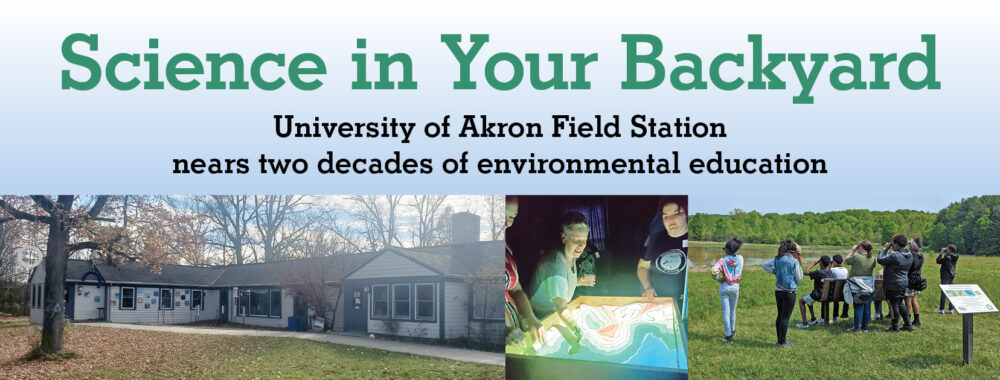University of Akron Field Station expands science education
by Laura Bednar
The University of Akron Field Station, located within the Bath Nature Preserve, has been a place for research, community engagement and education for almost 20 years.
The Field Station was established in 1998 with the mission to “serve the needs of the people of northeastern Ohio through research, education and service that promotes a better understanding of our relationship with the natural environment,” according to its website.
It encompasses three properties, the Dr. Paul E. Martin Center for Field Studies and Environmental Education – the professional name of the building in Bath Nature Preserve – the Panzner Wetland Wildlife Reserve and Steiner Woods. The building in the preserve was constructed in 2004 and is commonly referred to as the University of Akron Field Station.
Adding educational outreach has been the biggest change for the station over the years, according to Dr. Lara Roketenetz, who joined the field station team in 2015 and is now the Field Station director.
She is joined by a part-time assistant and a volunteer from the AmeriCorps service program. Dr. Randy Mitchell, University of Akron Biology professor, is the faculty director and focuses on research at the station. He teaches college-level courses including entomology and wetland ecology.
In 2023, the UAFS hosted over 1,000 students on field trips and taught more than 2,000 kids in the classroom. Students range from kindergarten through high school, and Roketenetz said the staff has worked with dozens of schools including Revere, Akron Public Schools, North High School, Copley/Fairlawn Schools, Cuyahoga Falls, Our Lady of the Elms, Walsh Jesuit and some Cleveland Public Schools, among others.
“Programs are place-based and we try to make them as experiential as we can,” said Roketenetz, adding that field trips allow children who don’t have access to nature to experience a 411-acre nature preserve.
Roketenetz also provides classroom instruction. Students at Bath Elementary School used the “Bath Bird Blitz Book,” published by Roketenetz and Bath residents John Landis and Alexander Landis, to write a report about a bird. Afterwards, they visited the preserve to view birds using binoculars.
“We want this to spark interest in them for lifelong learning,” said Roketenetz.
In addition to microscopes, insect nets and boots in all sizes, the Field Station has two new pieces of equipment: an augmented reality sandbox and a stream simulator. The sandbox uses a light projection that changes as the sand is moved to show topography. Students use the stream simulator to see how water moves through systems and they can build bridges or dams.
Roketenetz said the equipment makes students feel like budding scientists.
“Science can be monotypic,” she said. “We’re trying to change the impression of who can do science. We need people from all different backgrounds to solve environmental issues coming our way.”
Repetitive visits with students help to build relationships with them, according to Roketenetz. While the hope is to interest students in pursuing a science career, “[students] being aware of environmental issues and caring about protecting natural resources is a win, too,” she said.
Field Station outreach
Roketenetz recently made her seventh trip to Alaska to teach second-graders at Keet Gooshi Heen Elementary School in Sitka about animal adaptations and biomimicry. Biomimicry is creating inventions to solve human problems based on things found in nature. Roketenetz gave an example of a college student who created a robot that moved like a snake to access areas humans cannot.
Students in Alaska built “pompom picker uppers” inspired by a bird beak and learned about the life cycle of cicadas, according to the Sitka Sound Science Center field station newsletter.
Through the Organization of Biological Field Stations, of which Roketenetz is president, scientists worldwide shared their ideas at an international meeting in Costa Rica.
“The enormity of biodiversity there is incredible,” said Roketenetz. “Field stations all over the world are place-based to strengthen the relationship to nature.”
Field stations come together to work on extreme weather issues, share information and try to connect with artists to communicate science to the public through their work. In the same vein, the Bath field station hosts classes for adults to create art out of things found in nature.
Another goal for the OBFS is to expand the science community population. Roketenetz spoke at a conference last January about how to improve diversity, equity and inclusion in the field.
Future plans
Roketentz said the station plans to implement a monthly after school club for 30 students in underserved communities through the Ohio Environmental Education Fund. Curriculum would focus on biomimicry and combining art and nature for problem solving.
Roketenetz will teach a class in the spring called “One Health” which covers how humans, animals and the environment are all related and how societal issues may have a place-based solution. The class is through University of Akron’s EXL Center for Community Engaged Learning.
In collaboration with the Ohio State Extension system, the station will also offer an Ohio Certified Volunteer Naturalist class in late spring or early summer, open to the general public. Roketenetz said the hope is that people use the knowledge from the class within their communities. ∞

Dr. Lara Roketenetz visited Alaska for
the seventh time to teach second-graders
about animal adaptations and biomimicry.
Photo submitted.

Students learn about animals during a
classroom visit from the UAFS staff. Photo
submitted.
On our cover (photo) The University of Akron Field Station has a location in Bath Nature Preserve, offering education for students and the community. Dr. Lara Roketenetz demonstrates how the station’s augmented reality sandbox shows topography. Photos by Laura Bednar. A group of visiting students looks at the Garden Bowl wetland in the preserve. Photo submitted.

